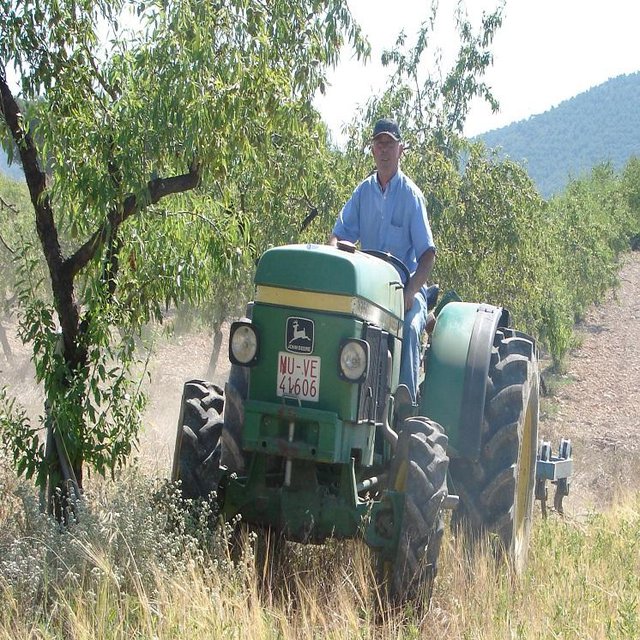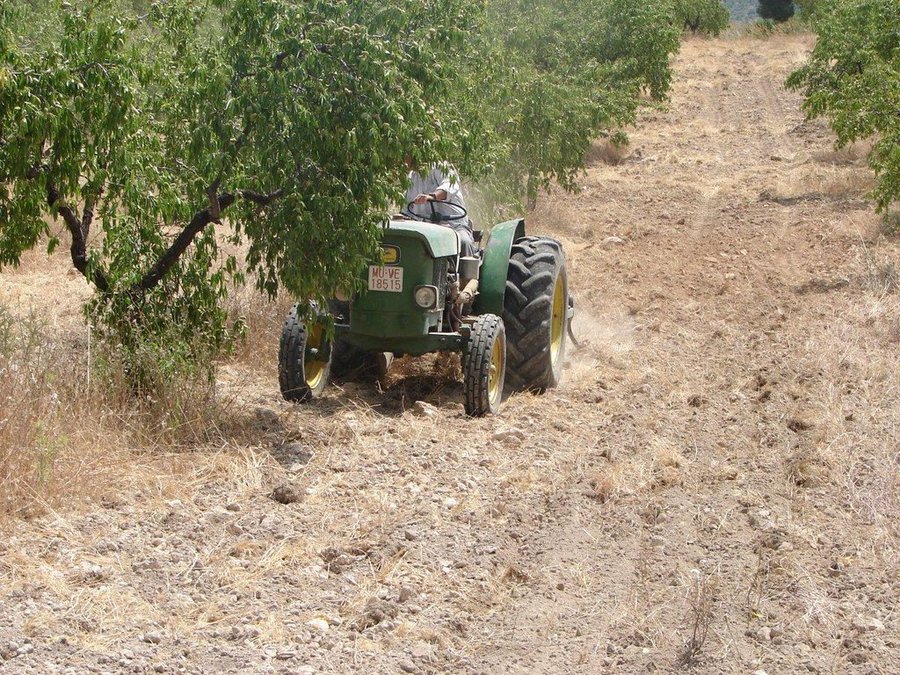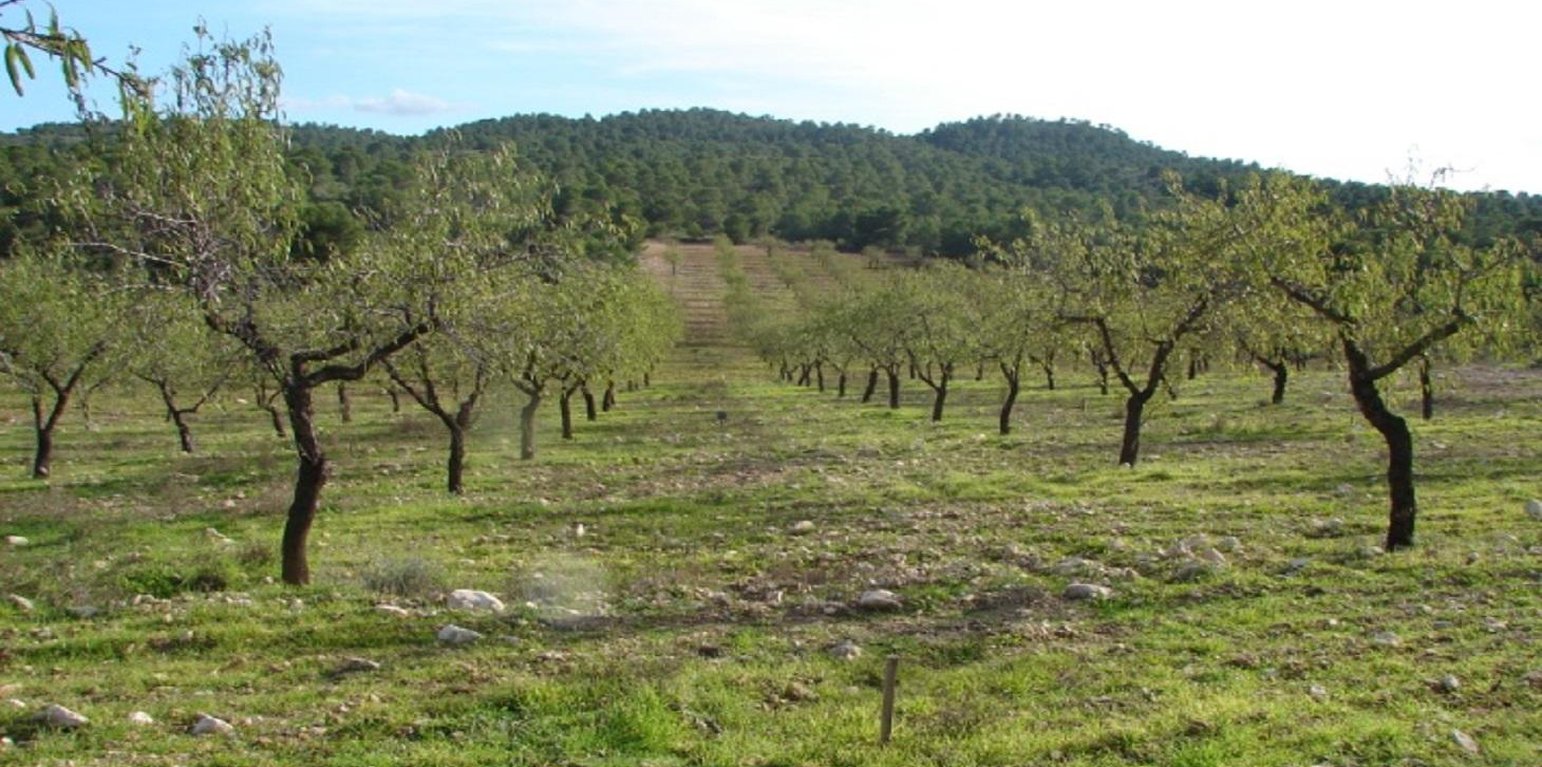Reduced tillage of almonds and olives
(Spain)
Labranza reducida de almendros y olivos
Description
Reduced tillage of almonds and olives to improve physical and chemical soil properties and reduce runoff and soil erosion.
Reduced tillage of almond and olive orchards is used to decrease fuel use and emission of greenhouse gases and maintain a higher surface cover by weeds during winter time in order to protect the soil from erosion.
Purpose of the Technology: Under reduced tillage, the fields are ploughed twice a year: once in autumn (November) and once in late sping (June), whereas under conventional tillage fields are ploughed 3-5 times per year. The aim of reduced tillage is to maintain better surface cover during winter months to reduce runoff and soil erosion. After several years this will result in a higher soil organic matter content, a better soil structure, and a higher soil water infiltration capacity. The soil cover by weeds reduces the sensitivity of the soil to surface crusting and reduces surface runoff and soil erosion by up to 60%. Workload and energy use with reduced tillage is up to 50% lower than under conventional agriculture. The increased farm income prevents land abandonment of marginal lands with low productivities under conventional farming. Reduced tillage of almonds does not require special establishment activities or investments in specialized equipment.
Natural / human environment: Reduced tillage can easily be combined with green manure and ecological agriculture as is described in QT SPA05: ecological production of almonds and olives using green manure. Soils have mostly a shallow to medium depth (between 20-60 cm), and slopes are gentle to moderate between 5 and 15%. The climate is semi-arid with a mean annual rainfall around 300 mm. Droughts, centred in summer, commonly last for more than 4-5 months. Annual potential evapotranspiration rates greater than 1000 mm are common. The production system is highly mechanized and market oriented but depends strongly on agricultural subsidies. All cropland is privately owned.
Location
![]()
Location: Guadalentín catchment, Murcia, Spain
No. of Technology sites analysed:
Geo-reference of selected sites
Spread of the Technology: evenly spread over an area (approx. 10-100 km2)
In a permanently protected area?:
Date of implementation: less than 10 years ago (recently)
Type of introduction
-
through land users' innovation
-
as part of a traditional system (> 50 years)
-
during experiments/ research
-
through projects/ external interventions

ploughing of a field with reduced tillage just before summer starts (Joris de Vente)
Classification of the Technology
Main purpose
-
improve production
-
reduce, prevent, restore land degradation
-
conserve ecosystem
-
protect a watershed/ downstream areas – in combination with other Technologies
-
preserve/ improve biodiversity
-
reduce risk of disasters
-
adapt to climate change/ extremes and its impacts
-
mitigate climate change and its impacts
-
create beneficial economic impact
-
create beneficial social impact
Land use
Land use mixed within the same land unit: Ja - Agroforestry
-
Cropland
- Tree and shrub cropping: olive, tree nuts (brazil nuts, pistachio, walnuts, almonds, etc.)
Water supply
-
rainfed
-
mixed rainfed-irrigated
-
full irrigation
Purpose related to land degradation
-
prevent land degradation
-
reduce land degradation
-
restore/ rehabilitate severely degraded land
-
adapt to land degradation
-
not applicable
Degradation addressed
-
soil erosion by water - Wo: offsite degradation effects
-
chemical soil deterioration - Cn: fertility decline and reduced organic matter content (not caused by erosion), Cp: soil pollution
-
biological degradation - Bp: increase of pests/ diseases, loss of predators
SLM group
-
improved ground/ vegetation cover
-
minimal soil disturbance
-
Reduced tillage
SLM measures
-
agronomic measures - A7: Others
Technical drawing
Technical specifications
Autumn ploughing of an almond orchard with reduced tillage
Technical knowledge required for field staff / advisors: high
Technical knowledge required for land users: moderate
Main technical functions: control of dispersed runoff: retain / trap, control of dispersed runoff: impede / retard, control of concentrated runoff: retain / trap, improvement of ground cover
Secondary technical functions: increase in organic matter, increase of infiltration, increase / maintain water stored in soil

Author: Joris de Vente
Establishment and maintenance: activities, inputs and costs
Calculation of inputs and costs
- Costs are calculated:
- Currency used for cost calculation: n.a.
- Exchange rate (to USD): 1 USD = n.a
- Average wage cost of hired labour per day: n.a
Most important factors affecting the costs
Costs were assessed comparing conventional land management with reduced tillage, which needs less inputs thus meaning a saving compared to conventional practice (97 USD per hectare per year). Fuel price is the most determining factor affecting the costs.
Establishment activities
n.a.
Maintenance activities
-
1. Ploughing twice a year instead of 3-5 times(resulting in a reduction of the costs compared to the conventional tillage practice) (Timing/ frequency: None)
Natural environment
Average annual rainfall
-
< 250 mm
-
251-500 mm
-
501-750 mm
-
751-1,000 mm
-
1,001-1,500 mm
-
1,501-2,000 mm
-
2,001-3,000 mm
-
3,001-4,000 mm
-
> 4,000 mm
Agro-climatic zone
-
humid
-
sub-humid
-
semi-arid
-
arid
Specifications on climate
Thermal climate class: subtropics
Slope
-
flat (0-2%)
-
gentle (3-5%)
-
moderate (6-10%)
-
rolling (11-15%)
-
hilly (16-30%)
-
steep (31-60%)
-
very steep (>60%)
Landforms
-
plateau/plains
-
ridges
-
mountain slopes
-
hill slopes
-
footslopes
-
valley floors
Altitude
-
0-100 m a.s.l.
-
101-500 m a.s.l.
-
501-1,000 m a.s.l.
-
1,001-1,500 m a.s.l.
-
1,501-2,000 m a.s.l.
-
2,001-2,500 m a.s.l.
-
2,501-3,000 m a.s.l.
-
3,001-4,000 m a.s.l.
-
> 4,000 m a.s.l.
Technology is applied in
-
convex situations
-
concave situations
-
not relevant
Soil depth
-
very shallow (0-20 cm)
-
shallow (21-50 cm)
-
moderately deep (51-80 cm)
-
deep (81-120 cm)
-
very deep (> 120 cm)
Soil texture (topsoil)
-
coarse/ light (sandy)
-
medium (loamy, silty)
-
fine/ heavy (clay)
Soil texture (> 20 cm below surface)
-
coarse/ light (sandy)
-
medium (loamy, silty)
-
fine/ heavy (clay)
Topsoil organic matter content
-
high (>3%)
-
medium (1-3%)
-
low (<1%)
Groundwater table
-
on surface
-
< 5 m
-
5-50 m
-
> 50 m
Availability of surface water
-
excess
-
good
-
medium
-
poor/ none
Water quality (untreated)
-
good drinking water
-
poor drinking water (treatment required)
-
for agricultural use only (irrigation)
-
unusable
Water quality refers to:
Is salinity a problem?
Occurrence of flooding
Characteristics of land users applying the Technology
Market orientation
-
subsistence (self-supply)
-
mixed (subsistence/ commercial)
-
commercial/ market
Off-farm income
-
less than 10% of all income
-
10-50% of all income
-
> 50% of all income
Relative level of wealth
-
very poor
-
poor
-
average
-
rich
-
very rich
Level of mechanization
-
manual work
-
animal traction
-
mechanized/ motorized
Sedentary or nomadic
-
Sedentary
-
Semi-nomadic
-
Nomadic
Individuals or groups
-
individual/ household
-
groups/ community
-
cooperative
-
employee (company, government)
Age
-
children
-
youth
-
middle-aged
-
elderly
Area used per household
-
< 0.5 ha
-
0.5-1 ha
-
1-2 ha
-
2-5 ha
-
5-15 ha
-
15-50 ha
-
50-100 ha
-
100-500 ha
-
500-1,000 ha
-
1,000-10,000 ha
-
> 10,000 ha
Scale
-
small-scale
-
medium-scale
-
large-scale
Land ownership
-
state
-
company
-
communal/ village
-
group
-
individual, not titled
-
individual, titled
Land use rights
-
open access (unorganized)
-
communal (organized)
-
leased
-
individual
Water use rights
-
open access (unorganized)
-
communal (organized)
-
leased
-
individual
Access to services and infrastructure
employment (e.g. off-farm)
drinking water and sanitation
Impacts
Socio-cultural impacts
recreational opportunities
SLM/ land degradation knowledge
Improved livelihoods and human well-being
Farm income of most farmers has increased due to lower production costs
Ecological impacts
soil organic matter/ below ground C
emission of carbon and greenhouse gases
Off-site impacts
damage on neighbours' fields
Cost-benefit analysis
Benefits compared with establishment costs
Short-term returns
very negative
very positive
Long-term returns
very negative
very positive
Benefits compared with maintenance costs
Short-term returns
very negative
very positive
Long-term returns
very negative
very positive
Climate change
Gradual climate change
annual temperature increase
not well at all
very well
Climate-related extremes (disasters)
not well at all
very well
not well at all
very well
not well at all
very well
not well at all
very well
Other climate-related consequences
not well at all
very well
Adoption and adaptation
Percentage of land users in the area who have adopted the Technology
-
single cases/ experimental
-
1-10%
-
11-50%
-
> 50%
Of all those who have adopted the Technology, how many have done so without receiving material incentives?
-
0-10%
-
11-50%
-
51-90%
-
91-100%
Has the Technology been modified recently to adapt to changing conditions?
To which changing conditions?
-
climatic change/ extremes
-
changing markets
-
labour availability (e.g. due to migration)
Conclusions and lessons learnt
Strengths: land user's view
Strengths: compiler’s or other key resource person’s view
-
Reduced tillage has a very positive effect on the reduction of erosion and runoff, on soil quality and biodiversity
How can they be sustained / enhanced? If maintained it will lead potentially to higher yields after several years
-
Production costs are reduced
How can they be sustained / enhanced? Yield and farm income may be increased by combining this technology with green manure under ecological agriculture (QT SPA05)
Weaknesses/ disadvantages/ risks: land user's viewhow to overcome
Weaknesses/ disadvantages/ risks: compiler’s or other key resource person’s viewhow to overcome
-
On the short term no increase in yield is obtained
Combine the technique with green manure or ecological agriculture as described in QT SPA05
References
Reviewer
-
Deborah Niggli
-
Alexandra Gavilano
Date of documentation: Mei 4, 2015
Last update: Aug. 1, 2019
Resource persons
-
Joris De Vente - SLM specialist
Full description in the WOCAT database
Documentation was faciliated by
Institution
- EEZA-CSIC (EEZA-CSIC) - Spain
Project
Key references
-
Holland, J.M., 2004. The environmental consequences of adopting conservation tillage in Europe: reviewing the evidence. Agriculture, Ecosystems & Environment, 103(1): 1-25.:












